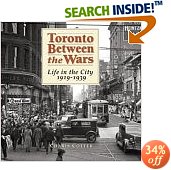Toronto Between the Wars: Life in the City 1919-1939

by Charis Cotter
ISBN: 1552978990
Post Your Opinion | | A Review of: Toronto Between The Wars: Life In The City 1919-1939
by Greg GatenbyCharis Cotter sagely remarks in Toronto Between The Wars that most
of the buildings for which Toronto has been known for decades were
built between World Wars I and II: the Royal York Hotel, Maple Leaf
Gardens, the Bank of Commerce head office, Eaton's College Street,
and Union Station. These buildings are of only modest architectural
interest. Nevertheless they became symbols of the City because
Toronto was so profligate in destroying its masterpieces from the
Victorian era it had little better to offer. Those looking for
plangent discussion of what WWI and the Depression meant to
Torontonians will have to look elsewhere. This is a book of
photographs with large captions-not a text-rich historical review
on the interbellum years (for which Jim Lemon's Toronto Since 1918
remains the standard). Moreover, it has to compete with the dozens
of extant books celebrating Toronto's past largely through historical
photos, a field which Mike Filey dominates. What distinguishes
Cotter's book from these others is its focus on a mere twenty-year
window. Within that perimeter the book has merits and demerits.
In its favour is the fact that it is attractively designed, with
lots of white space on the pages allowing for easy reading and
viewing-almost always now a feature of Firefly's original publications.
Also noteworthy is the quality of the photo reproductions, printed
with fine screens. The captions occasionally reveal information or
anecdotes which previous books have overlooked but they are aimed
mainly at those who know little of the city's past.
One striking revelation from such a concentrated look is just how
ugly Toronto was after the Great War. The treed and wide streets
of the Victorian era, and the houses and buildings made with that
distinctive blonde brick, gave way, by and large, to functional
monstrosities. Probably due to Toronto's inbred conservatism and
Calvinist fear of splendour, no major edifice was constructed in
this era whose exterior shamelessly bore the Art Deco style so
prevalent elsewhere. New York got the Chrysler Building; Toronto
got the Bank of Commerce made in a style already decades out of
date when it opened. My main reservation about this volume is
described by the author herself: "The choices of photos and
subjects in this book are personal and, in some ways, arbitraryI
let the pictures lead me to the stories." This may be an ideal
way to show home movies to friends, but, as an organizational
principle for a book purporting to be a history of a specific period,
it is hopeless. The reader is bumped from topic to unrelated topic
like a pinball. In other words, the book is best perused in short
bursts where the photos, many of which have not been published
before, can be savoured in small groups.
|